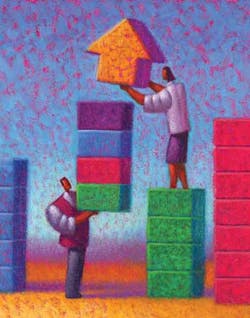The private sector has played a central role in facilitating sustainable and strong growth across the South Asia region. Numerous countries in the region are undergoing industrialization and expansion of local distribution infrastructures. This augurs well for automation sectors.
“Evidence is growing that South Asia is moving onto a higher growth path. But future growth will require progress on reforms across the region,” said Asian Development Bank (ADB) Chief Economist Ifzal Ali, while launching the 2006 edition of ADB’s flagship annual economic publication, “Asian Development Outlook.” “Focused investment aimed at breaking infrastructure bottlenecks in key economies would also open the door to stronger growth in the medium-term,” he said.
The people of South Asia constitute more than one-fifth of mankind and are heirs to great civilizations—yet they face momentous problems of poverty, illiteracy and deprivation. Though the governments of the South Asian Association for Regional Cooperation (SAARC) nations have made efforts since independence to improve the condition of their people, these attempts are often thwarted by multifarious religious, ethnic and linguistic problems.
Jump-starting growth
Richard A. Boucher, U.S. Assistant Secretary for South and Central Asian Affairs says, “Our economic programs are intended to jump-start development and growth by helping to build capacity and encouraging changes in the policies and regulations that hamper the strong entrepreneurial spirit that pervades South Asia. These programs run the gamut, from micro-enterprise programs in Bangladesh to entrepreneurship centers in Pakistan, from trade facilitation in Sri Lanka and customs reforms at borders in Afghanistan, to institutional reforms in India—all essential components of creating healthy economies and trading partners. India’s economy is already growing at a rate of around 8 percent a year, fueled in no small part by trade and investment with its largest trading partner, the United States.”
Growth in South Asia was on track for 2005, with India continuing to expand at a brisk pace, Pakistan posting its fastest growth in more than two decades, and Bangladesh growing steadily. India’s outlook continues to look bullish in 2006, lifting the sub-regional average for South Asia to 6.6 percent. Some estimates project that India’s gross dometstic product (GDP) growth could be clipped by up to 1.1 percentage points if oil prices remain around $70 per barrel through the end of 2006. But this negative impact is expected to be offset by other positive effects, including the government’s initiatives on infrastructure investment, the ADB report says.
Country outlooks
GDP growth in Bangladesh is forecast at 6.5 percent in FY2006 (beginning April 1, 2006), reflecting a steady increase in domestic and external demand, with a moderation to 6 percent in FY2007.
Bhutan has established a record of sustained solid growth based on utilization of its vast hydropower resources for export, sound policies, and strong support from development partners. GDP growth is expected to rise about 2 percentage points each year to 10 percent in 2006 and 12 percent in 2007.
India’s growth has averaged more than 8 percent over the past three years, driven by broad-based domestic demand and expansive business dynamics. The Maldives was hit hard by the 2004 tsunami, and GDP is estimated to have fallen 5.5 percent in 2005. GDP is expected to grow 9 percent in 2006, moderating to 6 percent in 2007.
In Nepal, the economy faltered in 2005, so GDP growth is forecast to slow to 2 percent in FY2006 because of poor weather affecting production of both winter and summer crops. Growth is projected to pick up to 3.4 percent in FY2007.
Pakistan grew 8.4 percent in 2005, its fastest rate of growth in the past two decades, but inflation also pushed higher, and the current account slipped from surplus to deficit. Growth is projected to soften to 6.5 percent in FY2006, mainly due to slower agricultural output, and to pick up to 7.3 percent in FY2007.
The economic impact of the tsunami on Sri Lanka was muted, despite its devastating human cost. Talks between the Government and the Liberation Tigers of Tamil Eelam in February 2006 have improved the overall climate on the status of the cease-fire. Accordingly, GDP growth is forecast at 5.3 percent in 2006 and 5.2 percent in 2007.
Unfounded fears
The fears of any of the SAARC countries that economic cooperation might destroy their own domestic economy are unfounded, according to the report. However, India, the largest democracy in the world, still fears that terrorist infiltration from Pakistani Islamic fundamentalist groups may upset the financial applecart.
Other underlying factors are higher private investment, and the positive outlook of entrepreneurs; the rise of consumerism among a rapidly growing middle class; a more aggressive attitude by financial institutions in consumer lending, as well as industrial and farm credit; the substantial business opportunities in exports; and expansion of market liberalization policies.
The future perfect?
Just seven months prior to the summit meeting of the SAARC member states, a Pakistan National Assembly member, Saleem Jan Mazari, asserted at a conference at the Indian Merchants Chamber (an apex body for trade, commerce and industry in the western region of India) that, “if the three countries, namely India, Pakistan and Bangladesh, came together, they would be the biggest consumer market in the world.”
Based on the idea of a unified ”South Asian market,” a businessman of Indian origin based in Singapore, A.R. Jumabhoy, prepared a document a month before the SAARC summit in which he claimed that India, Pakistan and Bangladesh, with a total population of close to 1.5 billion people and with a fairly impressive combined GDP, can offer larger sized markets for trade and industry.

